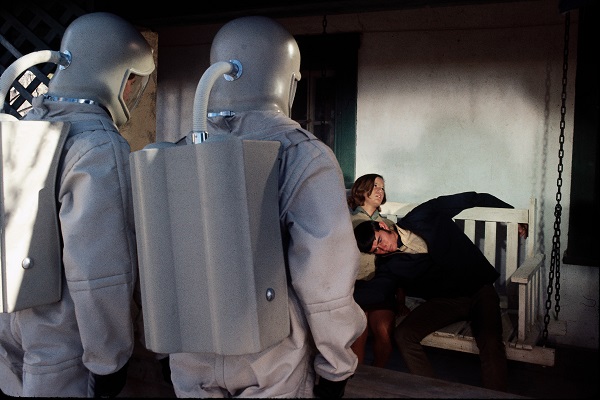Available on Blu-Ray from Mon 3 Jun 2019
This adaptation of Jurassic Park author Michael Crichton‘s 1969 novel begins with a government satellite crash landing outside a small town in New Mexico, resulting in the mass death of every resident with the exception of a baby and an elderly man. Scientists operating in an underground laboratory named Project Wildfire discover that the satellite brought back a deadly extraterrestrial virus code-named ‘Andromeda’ with the potential to eradicate all life on Earth.
Along with Silent Running and Soylent Green, The Andromeda Strain is part of an early 1970s era of science fiction films that focus on contemporary concerns about the future (virus pandemics, environmentalism, overpopulation) over the more escapist subject matter of later films such as the Star Wars and Alien films. This is reflected in Wise’s direction which, aside from the occasional innovative usage of split-screen montages, maintains a naturalistic, documentary-like feel, creating the impression that the events in the film could easily happen in reality.
This subtle approach is most effective in the opening scenes, where the discovery of the town and its deceased inhabitants are made all the more eerie by the lack of accompanying music and gore in the depiction of the corpses. In addition, the interactions between the scientists establishes their individual personalities in ways that don’t feel like contrived screenwriting quirks.
In particular, James Olson‘s Dr Mark Hall is provided with a number of semi-flirtatious interactions with female members of staff at Wildfire and Kate Reid‘s Dr Ruth Leavitt expresses a sarcastic sense of humour that helps to provide the few moments of levity in the otherwise serious narrative. The one exception to this naturalism would be early scenes between two of the male scientists and their family members, which feel like cliched scripted moments from 1950s science fiction films.
The production design by William Tuntke further adds to the realism, with the colour-coded rooms of the Wildfire laboratory as well as its seemingly-bottomless nuclear self-destruct mechanism being described on the film’s theatrical release as ‘one of the most elaborately detailed interiors ever built.‘
It is in this reactor that the film’s climax occurs This feels somewhat low-key in comparison to the likes of the Death Star run and Ripley running from the Xenomorph, yet its simplicity is not only consistent with the overall tone of the film, but its resolution is not as clear-cut or as reassuring as these later examples.
This further reinforces the attempted realism of not only The Andromeda Strain, but of mainstream film-making of the early 70s; a time where uncertainty had not yet become synonymous with box office failure or sequel baiting, but instead reflected the current mood of Vietnam and Watergate-era America. Could such an approach work with a Hollywood science fiction film today?
